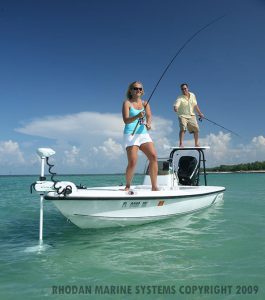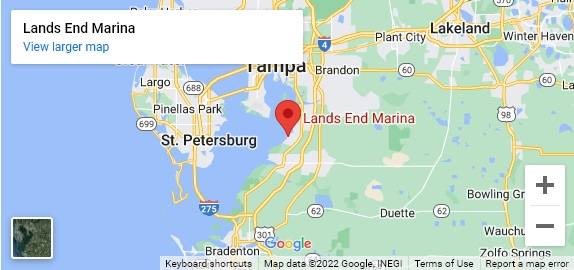When fishing in shallow water commonly found in Tampa Bay or around structures, being able to maneuver the boat quietly and efficiently is one of the keys to catching more fish. Since you don’t want to hire a personal trainer so you can paddle everywhere, trolling motors are usually mounted on small to medium size fishing boats such as skiffs, flats boats, bay boats, and bass boats. Whether you are cruising down a shoreline casting to the bank or sneaking up on fish over a large expanse of open water the right trolling motor can make the job much easier. There are several types of trolling motors. Each type is better suited to a particular type of boat. Trolling motors can be mounted on the bow or on the transom either in single or duel configurations. They can be either 12 volt, 24volt, or even 36 volt depending on power output. A trolling motors power is measured in pounds of thrust.
Transom mount trolling motors
Most transom mount trolling motors are used on smaller boats like jon boats and skiffs. They are usually on the low end of the power range and simply clamp to the transom either next to the outboard or in place of it. They commonly have alligator style clips that are attached directly to a battery. This style is set up to be taken on and off the boat for a days fishing. They are lighter than their permanently mounted brethren but usually considerably less powerful. The rule of thumb on this style is buy as big as you want to carry keeping in mind the size of the boat you are trying to push and the area you will be fishing. Most small jon boats and skiffs will do fine with a trolling motor in the 40 pounds of thrust range. If you are fishing in an area with very little wind then you can go with a less powerful motor but with any wind at all you will not make any headway. The exception to the transom mount motor being a small boat tool is a “tarpon setup” on a flats boat. This configuration is less common but it consists of two larger saltwater series trolling motors mounted on either side of the transom. Usually they are on tabs that are welded to a poling platform. They can be controlled with either a foot pedal or air buttons that will power one or the other or both. Turn on one and the boat turns the opposite way, turn on both and the boat goes straight. This set up involves more rigging and buying two trolling motors but where it shines is during fly fishing. While fly fishing especially for big fish like tarpon the angler has a bunch of line stripped off the reel and laying on the deck at his or her feet. When a fish is hooked that line comes off the deck at rocket speed and it will get caught on anything on the front deck of the boat. So in this case a bow mount trolling motor would actually do more harm than good.
Bow mount trolling motors
 By far the vast majority of trolling motors on boats today are bow mounts. These are bolted to the front deck of the boat and are controlled by hand, foot pedal, or remote control. The simplest to use is a hand control. The head of the motor is mounted opposite of the foot so it is operated by standing on the front deck of the boat and turning the handle the direction you want the boat to go. The speed and on/off controls are built into the handle so it is a one handed operation. Usually regulated to bass boats, foot control trolling motors allow you to be hands free. It is operated by a pedal with either steering cables or electronic controls. The advantage is that it is hands free, the disadvantage is that you have to stand on one foot because any pressure on the pedal will change the boats course. This is why they are mainly found on bass boats due to the front deck having a seat or a leaning post. The latest and greatest models are controlled electronically from a key fob you can wear around your neck. On/off, speed, and direction are all controlled though the key fob. Many of this style also incorporate GPS into the unit allowing you to pick a course and automatically go there without any input. Or retrace your path up and down a stretch of shoreline without having to do anything. The less work you have to do to fish means more time actually fishing and these models are designed to do just that.
By far the vast majority of trolling motors on boats today are bow mounts. These are bolted to the front deck of the boat and are controlled by hand, foot pedal, or remote control. The simplest to use is a hand control. The head of the motor is mounted opposite of the foot so it is operated by standing on the front deck of the boat and turning the handle the direction you want the boat to go. The speed and on/off controls are built into the handle so it is a one handed operation. Usually regulated to bass boats, foot control trolling motors allow you to be hands free. It is operated by a pedal with either steering cables or electronic controls. The advantage is that it is hands free, the disadvantage is that you have to stand on one foot because any pressure on the pedal will change the boats course. This is why they are mainly found on bass boats due to the front deck having a seat or a leaning post. The latest and greatest models are controlled electronically from a key fob you can wear around your neck. On/off, speed, and direction are all controlled though the key fob. Many of this style also incorporate GPS into the unit allowing you to pick a course and automatically go there without any input. Or retrace your path up and down a stretch of shoreline without having to do anything. The less work you have to do to fish means more time actually fishing and these models are designed to do just that.
How big is enough?
Once you have decided on the right style of motor to suit your needs you then have to decide on the size. The size of the boat will determine the pounds of thrust needed as well as the length of the shaft. Once deployed the shaft on the motor needs to be long enough to remain submerged during rough water as well as when most of the weight is in the back of the boat. If not, the spinning blade will break through the surface with so much noise and splashing that every fish in the county will get spooked. Most of the 12 volt trolling motors will be in the 50 inch shaft range. This will accommodate a light 17 foot rig. For most of your 24 volt systems a 60 inch shaft will get the job done. On the biggest boats that are still within reason to put a trolling motor on the 72 inch shaft will work. Every boat is different but when in doubt you can always raise the motor up on a longer shaft but if it’s too short they will not stretch. The next thing you have to decide is how powerful you want your trolling motor to be. Most of the time the pounds thrust and shaft length will correlate because trolling motors are designed on a general scale. Meaning that if it is strong enough to pull a certain size boat then the shaft length it is offered in is probably a good match to that boat. This rings true more on the larger trolling motors. On small light flats and bass boats a 12 volt system can be used, usually around 55lbs of thrust. This would be a good choice on a light 17 foot boat. Any bigger than that and you have to step up to a 24V model. They range in power form about 70 pounds of thrust to around 82 pounds. This is the most common size on your 18 to 22 foot boats. They have considerably more power to pull around a larger boat. The biggest trolling motors are 36 volt. These are reserved for the biggest practical fishing boats or a boat that needs lots of power for wind and current. They are usually around 100 pounds of thrust. While more power is always better one thing to take into consideration is the battery room in the boat and battery placement. Batteries can add a lot of weight and take up a ton of room. With a 24 volt system you have to have room for at least three batteries on board and place them somewhere that they won’t cause the boat to list or porpoise while underway. With a 36 volt system the number of batteries increases to at least four. The trolling motor, regardless of size or voltage should always be on its own set of batteries separate from the battery or batteries that run the boat. If not after a long day of fishing when you are ready to go home that big motor may not have enough juice to start. Another good reason is that the boat runs on a 12 volt system, not 24 volt or 36 volt like the trolling motor. If for some reason 24 volts were to get to your outboard or the accessory system in the boat you would be facing a hefty repair bill in wiring and electrical components. You will also need a charger to bring the batteries back to life after a day on the water. The easiest way, especially on multiple battery setups, is to install an onboard charger. This charger will have one plug that controls charging all the batteries on the boat. Plug it in and the next morning you are ready to go again. Somthing else to keep in mind when picking your motor is the size wire that is connecting the batteries to the trolling motor. The larger the battery cable the more usable power the motor will have and the more runtime you will get out of a full charge, so don’t skimp on the wire. Battery cable is expensive but if you spent a bunch of money on a trolling motor you don’t want to handicap it from the start. Always add a circuit breaker inline to the positive side of the plug with any permanently mounted trolling motor . This will limit the damage if the battery were to spike in voltage or if something shorts out in the trolling motor itself.
All in All Definitely Worth the Money
A trolling motor will make your boat better. It will allow you to fish places that were either a pain to fish or couldn’t be fished at all. The most important part is picking the best one for your boat and the style you fish. Once properly rigged you will be really happy that you spent the money. A shop such as ours can help you decide which one to buy, how to rig it, and even rig it for you. Then all you have to do is put it in the water and start chasing fish, only this time you will be doing it quietly.


